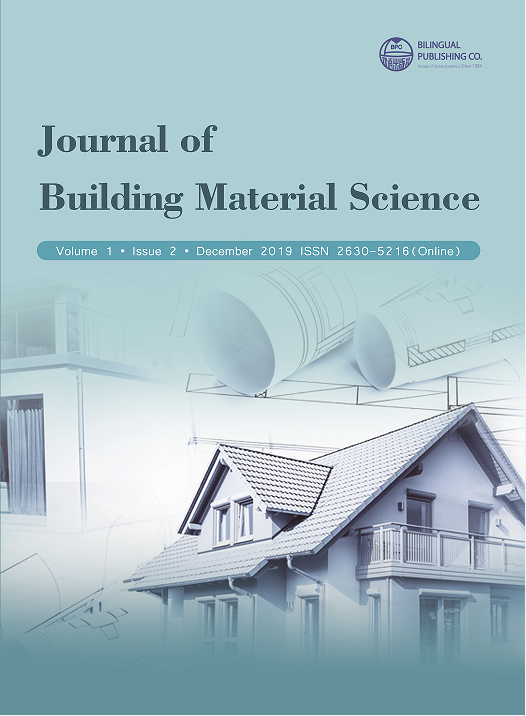-
1713
-
1258
-
1252
-
1149
-
1088
A Review on Progressive Collapse Designing Based on UFC Regulation
DOI:
https://doi.org/10.30564/jbms.v1i2.1257Abstract
Progressive collapse is a relatively rare event which happens due to unusual loading on a structure that lacks adequate continuity, ductility and indeterminacy which causes local collapse in that structure and then extends it to other structural parts. In 2003, US defense department to published regulations UFC 4-023- 03 on the building design against progressive collapse and in 2009 submitted a revised version of the regulations. This regulation, based on the ASCE 7-05 standard, introduces two general approaches to building design against progressive collapse, including direct design and indirect design approaches. In this study, a variety of structural design methods for progressive collapse have been investigated. Moreover, their strengths and weaknesses have been mentioned. In general, the results of this study show that design based on AP is more economical than other methods. Also, using this method is much more commonly accepted by researchers and designers.
Keywords:
Progressive collapse, Alternative path method, Specific local resistanceReferences
[1] Unified Facilities Criteria (UFC)-DoD. (2005). Design of buildings to resist progressive collapse. Department of Defense.
[2] ASCE. SEI/ASCE 7-05. (2005). minimum design loads for buildings and other structures. Washington DC: American Society of Civil Engineers.
[3] Office of the Deputy Prime Minister. (2005). The building regulations 2000, Part A,Schedule 1: A3, Disproportionate collapse. London (UK)
[4] British Standards Institution. BS 5950: (2001). Structural use of steelwork in buildings, Part 1: Code of practice for design _ Rolled and welded sections. London (UK).
[5] Rohola Rahnavard, Faramarz Fathi Zadeh Fard, Ali Hosseini, Mohamed Suleiman, (2018). Nonlinear analysis on progressive collapse of tall steel composite buildings, Case Studies in Construction Materials 8 359–379
[6] Rohola Rahnavard, Navid Siahpolo, (2018). Function comparison between moment frame and moment frame with centrically braces in high-rise steel structure under the effect of progressive collapse, Journal of Structural and Construction Engineering, Volume 4, Issue 4 - Serial Number 14, Page 42-57, DOI:https://doi.org/10.22065/jsce.2017.77865.1084
[7] Rohola Rahnavard, Akbar Hassanipour, (2015). Steel Structures analysis using ABAQUS, Kerman: Academic Center for Education, Culture and Research, Publishing Organization of Kerman branch
[8] Sahar Radkia, Farhad Abbas Gandomkar, Rohola Rahnavard, (2018). Seismic Response of Asymmetric Sliding Steel Structure with Considering Soil-Structure Interaction Effects, Journal of Structural and Construction Engineering, DOI: https://doi.org/10.22065/JSCE.2018.105638.1384
[9] Sahar Radkia, Rohola Rahnavard, Farhad Abbas Gandomkar, (2018). Evaluation of the effect of different seismic isolators on the behavior of asymmetric steel sliding structures, Journal of Structural and Construction Engineering, DOI: https://doi.org/10.22065/JSCE.2018.114089.1428
[10] Sahar Radkia, Rohola Rahnavard, Hesham Tuwair, Farhad Abbas Gandomkar, Rebecca Napolitano, (2020). Investigating the effects of seismic isolators on steel asymmetric structures considering soil-structure interaction, Structures, Volume 27, Pages 1029-1040
[11] Abolhassan Astaneh-Asl, Brant Jones, Yongkuan Zhao, Ricky Hwa, (2001). PROGRESSIVE COLLAPSE RESISTANCEOF STEEL BUILDING FLOORS, FINAL REPORT.
[12] Rohola Rahnavard, Robert J. Thomas, (2018). Numerical Evaluation of the Effects of Fire on Steel Connections; Part 1: Simulation Techniques, Case Studies in Thermal Engineering. Vol 12, page 445-453
[13] Rohola Rahnavard, Robert J. Thomas, (2019). Numerical Evaluation of the Effects of Fire on Steel Connections; Part 2: Model results, Case Studies in Thermal Engineering. Vol 13, DOI:https://doi.org/10.1016/j.csite.2018.11.012
[14] R Rahnavard, A Hassanipour, N Siahpolo, (2015). Analytical study on new types of reduced beam section moment connections affecting cyclic behavior, Case Studies in Structural Engineering 3, 33-51.
[15] Rohola Rahnavard, Navid Siahpolo, Mohammad Naghavi, Akbar Hassanipour, (2014). Analytical Study of Common Rigid Steel Connections under the Effect of Heat, Advances in Civil Engineering, vol. 2014, Article ID 692323, 10 pages. DOI: https://doi.org/10.1155/2014/692323
[16] Rohola Rahnavard, Maziyar Taghi Khaje, Akbar Hassanipour, Navid Siahpolo, (2017). Parametric Study of Seismic Performance of Steel Bridges Pier Rehabilitated with Composite Connection, Journal of Structural and Construction Engineering, DOI: https://doi.org/10.22065/JSCE.2017.92128.1259
[17] Akbar Hassanipour, Rohola Rahnavard, Ali Mokhtari, Najaf Rahnavard, (2016). Numerical investigation on reduces web beam section moment connections under the effects on cyclic loading”, J. Multidiscip. Eng. Sci. Technol.(JMEST) 2 (8), 3159-0040
[18] Seiyed Mahmoud Hosseini, Rohola Rahnavard, (2020). Numerical study of steel rigid collar connection affecting cyclic loading, Engineering Structures, Volume 208, 110314
[19] Rohola Rahnavard, Carlos Rebelo, Hélder D. Craveiro, Rebecca Napolitano. (2020), Understanding the cyclic performance of composite steel-concrete connections on steel bridges, Engineering Structures, 224, 111213
[20] Sasani, M. (2008). Response of a reinforced concrete infilled-frame structure to removal of two adjacent columns”. Engineering Structures, vol.30, no.9, pp. 2478-2491
[21] Jinkoo Kima, Taewan Kim. (2009). Assessment of progressive collapse-resisting capacity of steel moment frames, Journal of Constructional Steel Research, Volume 65, Issue 1, Pages 169-179
[22] Feng Fu, (2009). Progressive collapse analysis of high-rise building with 3-D finite element modeling method, Journal of Constructional Steel Research, Volume 65, Issue 6, Pages 1269-1278
[23] Rohola Rahnavard, Mohammad Naghavi, Maryam Abudi, Mohamed Suleiman, (2018). Investigating Modeling Approaches of Buckling-Restrained Braces under Cyclic Loads, Case Studies in Construction Materials, Case Studies in Construction Materials 8 476–488
[24] Rohola Rahnavard, Akbar Hassanipour, Ali Mounesi, (2016). Numerical study on important parameters of composite steel-concrete shear walls, Journal of Constructional Steel Research 121 441–456.
[25] Rohola Rahnavard, Akbar Hassanipour, Mohamed Suleiman, Ali Mokhtari, (2017). Evaluation on eccentrically braced frame with single and double shear panel, Journal of Building Engineering 10 13–25
[26] Mohammad Naghavi, Rohola Rahnavard, Robert J. Thomas, Mohsen Malekinejad, (2019). Numerical evaluation of the hysteretic behavior of concentrically braced frames and buckling restrained brace frame systems, Journal of Building Engineering, 22 415-428
Downloads
How to Cite
Issue
Article Type
License
Copyright © 2020 Javad Delfian

This is an open access article under the Creative Commons Attribution-NonCommercial 4.0 International (CC BY-NC 4.0) License.




 Javad Delfian
Javad Delfian





